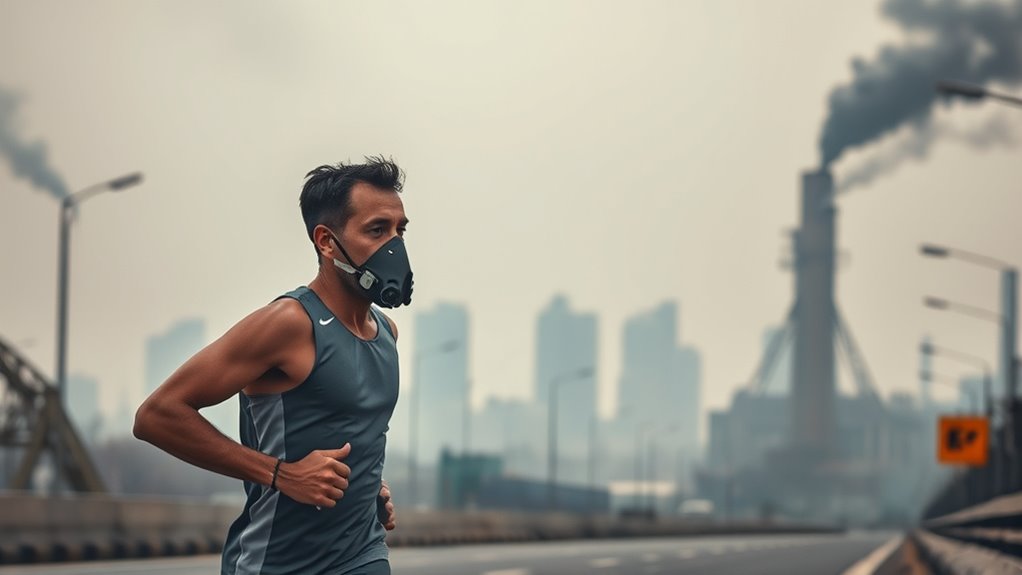To optimize your respiratory health as an endurance athlete, focus on improving lung capacity and respiratory muscle strength through breathing exercises and training. Protect yourself from pollutants and allergens, use proper breathing techniques, and incorporate nutritious foods like omega-3s and antioxidants to reduce inflammation. Adjust for altitude challenges with gradual exposure and monitor symptoms closely. Staying proactive with these strategies helps you breathe easier, perform better, and stay healthy — learn more to boost your respiratory wellness even further.
Key Takeaways
- Improving lung capacity and respiratory muscle strength through targeted exercises enhances oxygen delivery and delays fatigue.
- Recognizing early respiratory symptoms and avoiding pollutants helps prevent long-term airway issues.
- Proper breathing techniques and nutrition, including antioxidants and omega-3s, optimize lung function and recovery.
- Managing environmental factors like altitude, pollution, and allergens supports respiratory health and performance adaptation.
- Regular check-ups, immune support, and hydration are essential for long-term respiratory wellness and athletic success.
Understanding the Importance of Lung Capacity

Have you ever wondered why some endurance athletes can perform longer and more efficiently than others? It all comes down to lung capacity. Your lung capacity determines how much air you can inhale and exhale during activity. A larger capacity means more oxygen reaches your muscles, helping you sustain effort longer and recover faster. When your lungs are efficient, you utilize oxygen more effectively, delaying fatigue. Training can improve your lung capacity by strengthening your respiratory muscles and increasing your overall lung volume. This isn’t just about breathing deeply; it’s about optimizing how much air your lungs can hold and move. By understanding and improving your lung capacity, you give yourself a vital edge in endurance sports, enabling you to push harder and go farther. Additionally, incorporating exercises that target respiratory muscle strength can lead to significant improvements in overall lung efficiency.
Common Respiratory Challenges Faced by Endurance Athletes

As an endurance athlete, you’re likely to encounter respiratory challenges that can affect your performance. Conditions like exercise-induced bronchoconstriction, airway irritation from environmental factors, and increased risk of respiratory infections are common hurdles. Recognizing these issues is the first step to managing them effectively and maintaining your respiratory health. Additionally, understanding the importance of forsale 100 in supporting your overall health can contribute to better performance and recovery.
Exercise-Induced Bronchoconstriction
Exercise-induced bronchoconstriction (EIB) is a common respiratory challenge that many endurance athletes face, especially during intense training or competitions. It causes temporary narrowing of your airways, leading to symptoms like coughing, wheezing, shortness of breath, and chest tightness shortly after exercise. EIB isn’t the same as asthma, but it often occurs in athletes with or without a diagnosed condition. High ventilation rates, cold air, or dry environments can trigger EIB by dehydrating airway tissues and causing inflammation. To manage it, you might use pre-exercise inhalers or warm up thoroughly before activity. Recognizing early symptoms and adjusting your training can help prevent severe episodes, ensuring your respiratory system performs ideally during your endurance pursuits. Being aware of proper toilet maintenance and common issues can also help prevent unexpected disruptions during training trips or competitions.
Airway Irritation & Allergies
Airway irritation and allergies are common challenges that endurance athletes encounter, especially when environmental factors come into play. Exposure to pollutants, pollen, or dust can trigger inflammation and discomfort during training. To manage these issues, consider these key strategies:
- Monitor local pollen and pollution levels to plan workouts during cleaner times.
- Use nasal rinses or sprays to reduce irritants in your airways.
- Wear masks or buffs in high-allergen environments for added protection.
- Incorporating knowledge about airway irritation causes can help you better understand and prevent symptoms.
These steps help minimize irritation and keep your respiratory system functioning smoothly. Recognizing early signs of allergy-induced airway issues allows you to adjust your routine promptly. Staying proactive ensures you maintain ideal breathing and performance, even when environmental conditions challenge your respiratory health.
Respiratory Infection Risks
Endurance athletes often face an increased risk of respiratory infections, especially when environmental factors like pollutants and allergens compromise airway defenses. Intense training can temporarily weaken your immune system, making you more vulnerable. Cold weather, dry air, and high pollution levels further irritate your respiratory tract and hinder your body’s ability to fight off pathogens. Sharing equipment or training in crowded environments also increases exposure to viruses and bacteria. Symptoms like sore throat, cough, or congestion may signal an infection, which can impair your performance if not managed promptly. To reduce risks, focus on proper hygiene, avoid training outdoors during high pollution days, and prioritize recovery. Staying vigilant helps protect your respiratory health and keeps you performing at your best.
The Role of Proper Breathing Techniques in Performance

Have you ever noticed how your breathing can either boost or hinder your performance during intense activity? Proper breathing techniques optimize oxygen intake, improve stamina, and reduce fatigue. To maximize your performance, focus on these key areas:
- Breathe deeply from your diaphragm instead of shallow chest breathing to increase oxygen delivery.
- Maintain a steady, rhythmic pattern to enhance endurance and prevent unnecessary energy expenditure.
- Inhale through your nose when possible, filtering the air and promoting controlled, efficient breathing.
- Incorporating breath control techniques can further enhance your ability to sustain effort and recover quickly.
Mastering these techniques helps you stay relaxed, maintain better oxygen flow, and improve overall efficiency. When you breathe properly, you conserve energy, delay fatigue, and perform at your best during every workout or race.
Strategies to Reduce Airway Inflammation and Irritation

To minimize airway inflammation and irritation, you should adopt specific strategies that support respiratory health. First, avoid exposure to pollutants, allergens, and irritants by training in well-ventilated areas or indoors when pollution levels are high. Wearing a mask during high-exposure activities can also help. Stay hydrated, as proper hydration thins mucus and eases airflow. Incorporate anti-inflammatory foods like fruits, vegetables, and omega-3-rich sources into your diet to reduce inflammation. Additionally, consider using saline nasal sprays or rinses to clear nasal passages and remove irritants. Managing environmental factors and maintaining good hydration are essential steps for protecting your airways, especially during heavy training or in polluted environments. These strategies help keep your airways healthy and reduce the risk of inflammation and irritation. Regularly reviewing your personal finance management plan can also help ensure you have the resources to prioritize your health and wellness.
Incorporating Respiratory Muscle Training Into Your Routine

Incorporating respiratory muscle training into your routine can markedly improve your breathing efficiency and overall performance. By strengthening your diaphragm and intercostal muscles, you enhance airflow and reduce fatigue during exercise. To get started:
- Use devices like inspiratory muscle trainers to focus on breath control and strength.
- Incorporate daily breathing exercises, such as diaphragmatic or pursed-lip breathing, to build endurance.
- Gradually increase training intensity and duration to challenge your respiratory muscles without overtraining.
- Understanding RMDs and tax implications can help you plan your retirement savings to support ongoing health and wellness costs.
Consistent practice boosts lung capacity and efficiency, helping you recover faster and perform better under stress. Make respiratory muscle training a core part of your routine, complementing aerobic and strength workouts for *ideal* athletic results.
Environmental Factors That Affect Respiratory Health

Environmental factors can substantially influence your respiratory health and athletic performance. Air quality is a major concern—pollutants like smog, vehicle emissions, and industrial fumes can irritate your airways and reduce lung function. Allergens such as pollen, mold, and dust can trigger asthma symptoms or respiratory discomfort, especially during peak seasons. Humidity and temperature also matter; high humidity can make breathing feel more laborious, while cold air may cause airway constriction. Additionally, exposure to cigarette smoke or indoor pollutants can impair lung health over time. Recognizing these factors helps you take precautions, like exercising in cleaner environments or wearing masks when necessary. Staying aware of environmental conditions guarantees you protect your lungs and maintain ideal performance during training and competition. Understanding environmental impacts on lungs can also help you make informed choices about your training locations and times.
Nutrition for Lung Function and Respiratory Recovery

To support your lung health and speed up recovery, focus on incorporating lung-healthy nutrients like omega-3s and antioxidants. Eating anti-inflammatory foods and staying well-hydrated can reduce inflammation and promote efficient breathing. Prioritizing proper nutrition helps your respiratory system recover faster and perform at its best. Monitoring your performance metrics can also help you optimize your training and recovery strategies.
Lung-Healthy Nutrients
Certain nutrients play a essential role in supporting lung health and aiding respiratory recovery, especially for endurance athletes pushing their limits. These nutrients help reduce inflammation, strengthen lung tissue, and boost immune function. To optimize your respiratory health, focus on:
- Vitamin C – enhances immune response and repairs lung tissue.
- Omega-3 fatty acids – reduce inflammation and improve lung elasticity.
- Magnesium – relaxes airway muscles and supports breathing efficiency.
Consuming foods rich in these nutrients can help you recover faster and maintain peak respiratory function. Incorporate citrus fruits, fatty fish, nuts, and leafy greens into your diet regularly. Proper nutrition not only supports lung health but also enhances your overall athletic performance. Prioritize these nutrients to keep your lungs resilient and ready for demanding workouts. Understanding respiratory health is crucial for optimizing your performance and recovery.
Anti-Inflammatory Foods
Building on the importance of nutrient-rich foods for lung health, choosing anti-inflammatory options can considerably enhance your respiratory recovery. Incorporate foods like fatty fish—salmon, mackerel, and sardines—that are rich in omega-3 fatty acids, known for reducing inflammation. Berries such as blueberries, strawberries, and cherries contain antioxidants that combat oxidative stress in your lungs. Leafy greens like spinach and kale are packed with vitamins and phytochemicals that help lower inflammation. Nuts and seeds, especially walnuts and flaxseeds, provide healthy fats that support lung function. Including turmeric and ginger in your diet adds natural anti-inflammatory compounds. By consistently eating these foods, you support your body’s ability to recover faster, reduce respiratory soreness, and improve overall lung health, keeping you ready for your next endurance challenge.
Hydration and Recovery
Ever wondered how proper hydration accelerates your respiratory recovery after intense training? Staying well-hydrated helps clear mucus, reduces inflammation, and restores lung function faster. To optimize this process, focus on:
- Drinking enough water throughout the day, especially before, during, and after workouts.
- Incorporating electrolyte-rich drinks to replenish lost minerals and maintain fluid balance.
- Consuming water-dense foods like fruits and vegetables to support overall hydration and lung health.
Proper hydration ensures your airways stay moist, making breathing easier and reducing fatigue. It also helps flush out toxins and supports tissue repair. Remember, consistent hydration isn’t just about quenching thirst—it’s an essential part of your respiratory recovery and overall performance. Stay mindful of your fluid intake to breathe easier and recover faster.
Recognizing and Managing Respiratory Symptoms During Training

Recognizing respiratory symptoms early during training is essential for maintaining performance and preventing more serious issues. Pay attention to signs like persistent coughing, wheezing, shortness of breath, or chest tightness. If you notice these, slow down or pause your workout to assess how you feel. Keep track of when symptoms occur and their severity. Managing symptoms involves adjusting your pace, practicing controlled breathing techniques, and ensuring proper warm-up and cool-down routines. If symptoms persist or worsen, seek medical advice promptly. Ignoring early warning signs can lead to more severe respiratory problems that hinder your training and overall health. By staying attentive and responsive, you can address issues early, maintain your endurance goals, and protect your respiratory health.
The Impact of Altitude Training on Lung Adaptation

Altitude training can boost your lung capacity, helping you breathe more deeply and efficiently. It also enhances how your body uses oxygen, making every breath more effective during endurance events. Understanding these adaptations can give you a real edge in optimizing your performance.
Lung Capacity Enhancement
Have you ever wondered how training at high elevations boosts your lung capacity? When you train at altitude, your body adapts by increasing lung volume and improving breathing efficiency. This process involves three key changes:
- Your lungs expand to hold more air, which enhances overall capacity.
- The respiratory muscles strengthen, making each breath more effective.
- Your body produces more red blood cells, improving oxygen transport and utilization.
These adaptations help you breathe more deeply and efficiently, leading to increased lung capacity. Over time, your lungs become better at accommodating higher oxygen demands, which translates to improved performance in endurance activities. Altitude training pushes your respiratory system to adapt, ultimately boosting your lung capacity for better athletic endurance.
Oxygen Utilization Efficiency
Training at high altitudes enhances your body’s ability to efficiently use oxygen, not just increasing lung capacity. When you train where oxygen levels are lower, your body adapts by producing more red blood cells, improving oxygen transport to your muscles. This process boosts your oxygen utilization efficiency, meaning your muscles get more oxygen with each breath. Over time, your mitochondria become more effective at producing energy from oxygen, enhancing endurance and reducing fatigue. Altitude training also encourages your body to optimize blood flow and improve oxygen extraction at the cellular level. These adaptations translate to better performance when you return to lower altitudes, as your body can utilize oxygen more effectively, giving you a competitive edge during endurance events.
Preventive Measures for Long-term Respiratory Wellness

To maintain long-term respiratory health as an endurance athlete, implementing proactive preventive measures is essential. First, avoid exposure to pollutants and irritants by training in clean environments or using masks when necessary. Second, prioritize regular respiratory check-ups to catch issues early and monitor lung function. Third, strengthen your immune system through proper nutrition, adequate sleep, and stress management, reducing the risk of respiratory infections. Additionally, stay hydrated to keep mucus thin and support lung function. Incorporate breathing exercises into your routine to enhance lung capacity and resilience. These steps help safeguard your respiratory system, ensuring it remains strong and efficient for sustained athletic performance over the years.
Frequently Asked Questions
How Does Cold Weather Affect Endurance Athletes’ Respiratory Health?
Cold weather can remarkably impact your respiratory health, especially during endurance activities. As you breathe in chilly air, your airways may tighten and become inflamed, making it harder to breathe. You might also experience increased mucus production or coughing. To protect yourself, wear a mask or scarf over your nose and mouth, warm up thoroughly, and stay aware of any breathing difficulties. These steps help maintain your respiratory health in cold conditions.
Can Altitude Training Improve Lung Capacity Permanently?
You might think altitude training magically boosts your lung capacity forever, but the truth is, it’s more like a temporary boost. While it can improve your oxygen efficiency and endurance, your lungs won’t permanently expand just from altitude sessions. Once you return to sea level, those gains tend to level off. So, enjoy the temporary upgrade, but don’t expect your lungs to become permanently larger overnight.
What Are the Signs of Respiratory Overtraining?
You might notice signs of respiratory overtraining if you feel unusually short of breath during workouts, experience persistent coughing, or have increased mucus production. Fatigue, chest tightness, and trouble recovering from exercise are also common. If your breathing feels labored even at rest or worsens over time, it’s a clear sign you need to reduce intensity and allow your respiratory system to recover. Listening to your body helps prevent further issues.
How Do Respiratory Infections Impact Training Schedules?
When you face respiratory infections, your training schedule takes a hit, and your progress stalls. You may experience reduced stamina, increased fatigue, and longer recovery times. These infections weaken your immune system, making you more prone to setbacks and injuries. You need to prioritize rest, recover fully, and avoid pushing through illness. Listening to your body helps you adapt your schedule, ensuring you return stronger and healthier, avoiding long-term setbacks.
Are There Specific Breathing Aids Beneficial for Endurance Athletes?
You’re wondering if specific breathing aids can boost your performance. While some athletes use devices like inspiratory muscle trainers or nasal strips, their benefits vary. These aids can improve lung capacity, reduce breathing effort, and enhance airflow. However, not everyone needs them, and proper training techniques often provide better results. Try experimenting with different aids under professional guidance to see what works best for your endurance and breathing efficiency.
Conclusion
Taking care of your respiratory health isn’t just about breathing easier—it’s about revealing your full endurance potential. By understanding your lungs, mastering breathing techniques, and staying proactive, you’re setting the stage for peak performance. Remember, your lungs are the wind beneath your wings—nurture them, and you’ll soar farther, faster. Embrace these strategies, and let your breath carry you to new heights in every race and workout.









